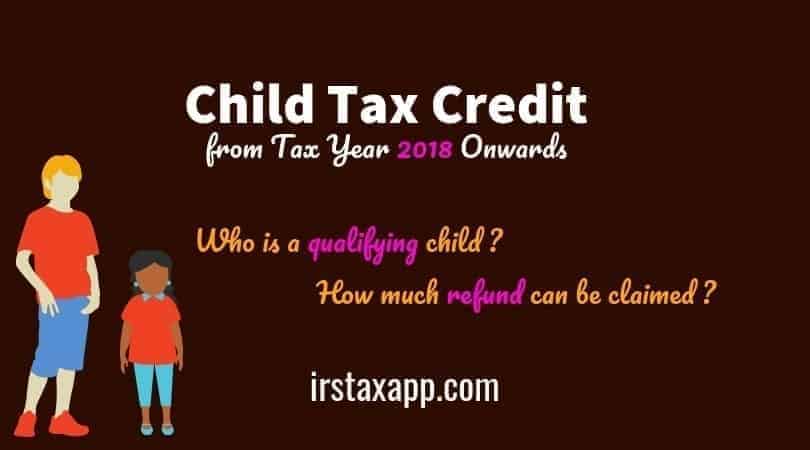
The Child Tax Credit law under section 24 of the 26US Code has changed a lot from the tax year 2018 with the passage of the Tax Cuts & Jobs Act. Earlier i.e before TCJA, a taxpayer could claim a tax credit worth up to $1,000 per qualifying child. but from the tax year 2018 onwards, you can claim tax credit $2000 per qualifying child. So, what child tax credit IRS allows in 2018 or 2019?
Table of Contents
New Child Tax Credit Rules from 2018
Major child tax credit changes are as under :
- The Child Tax Credit is now worth up to $2,000 per qualifying child.
- The refundable portion of the child tax credit is limited to $1,400 ( 15% of earned income ) for the tax year 2018 subject to income phaseout.
- The age cut-off remains at 17 at the end of the year. Further, a valid SSN to the child is a must to qualify for Child Tax Credit.
- The minimum income that you must earn for claiming child tax now to $ 2,500.Earned income can be from wages, salary, tips, employer-based disability, self-employment income, military pay, etc
- The beginning credit phaseout for the child tax credit starts at $200,000 ($400,000 for joint filers).
- From the year 2018, you can claim an additional non-refundable tax credit of $500 for qualifying relatives who may not necessarily have to be children below 17 This is explained later in this article.
Since this credit is non-refundable, it can only help reduce taxes owed. If you can claim both this credit and the CTC, this will be applied first to lower your taxable income.
Who is a “Qualified Child” for the Child Tax Credit?
The newly amended law for a claim of the child tax credit as altered the eligibility conditions states that the child must be a qualified child. So we need to understand “Who is a qualified child ?” for the purpose of the claim of the child tax credit. A qualifying child is one :
- Who is of age 16 or younger – at the end of the year.
- Who is related to the claimant of the child tax credit as a – son, daughter, stepchild, foster child, brother, sister, stepbrother, stepsister or a descendant of any of these individuals (includes your grandchild, niece, or nephew) or is a legally adopted child
- The child must not have provided more than half of their own support for the year.
- You must claim the child as a dependent and that you provided at least half child’s support during the tax year.
- The child must be a U.S. citizen, U.S. national, or U.S. resident alien.
- The child must be resident of ( means lived with you for more than half of the tax year. although there is some exception. Refer to IRS Publication 972, Child Tax Credit.
- The child must have a Social Security Number before due date of filing tax return.
What is Child Tax Credit Income Levels & Phaseout ?
Child tax credit phaseouts with a modified adjusted gross income (MAGI) of more than $200,000 for all taxpayers except married filing jointly in whose case phaseout begins at $ 400,000.
How phaseouts work ?
Under new rule of phaseout computation, there is child tax by of $50 for each increase of $1,000 of Modified Adjusted Gross Income. It is clear that the new child credit rule helps you more if you have income because the phaseout begins at $ 200,000 ($400000 filers). On the you earn less or have no earned income at all, the Child Tax Credit is either very less or of no help at all !.
Can You Claim Refund of the Child Tax Credit?
The answer is a definite yes provided there is a balance of child tax credit eliminating any taxes you owe. If that be the case , you can claim a refund by submitting child tax credit form Schedule 8812, the “Additional Child Tax Credit” with your tax return.
The refundable portion is equal to 15% of your earned income over $2,500, up to $1,400. To estimate how much of the refund you would receive, you can use the following equation:
(Your salary – $2,500) x .15
$500 Additional Dependent Credit
This is from the tax year 2018 onwards, courtsey TCJA. The additional $500 non-refundable tax credit is available to anyone who satisfies following three conditions
(i) provides half the financial support to a parent or grandparent, stepparent, aunt or uncle, niece or nephew, in-laws, or someone who lives in your home all year long, and
(ii) the dependent doesn’t earn more than $4,150 (for year 2018).
The qualifying dependent must be a U.S. citizen, U.S. national, or U.S. resident alien.
The additional tax credit of $ 500 is counted along with main child tax credit for a single phase out when adjusted gross income exceeds $200,000, or $400,000 if married filing jointly.
Post Disclaimer
While the information on this site - Internal Revenue Code Simplified-is about legal issues, it is not legal advice or legal representation. Because of the rapidly changing nature of the law and our reliance upon outside sources, we make no warranty or guarantee of the accuracy or reliability of information contained herein.
